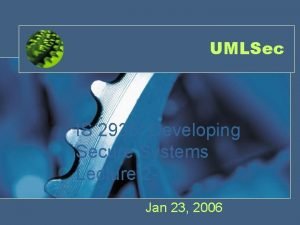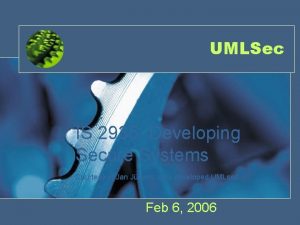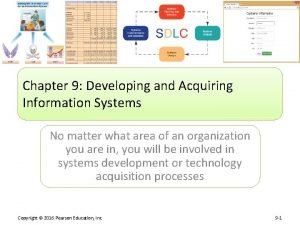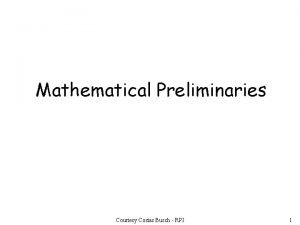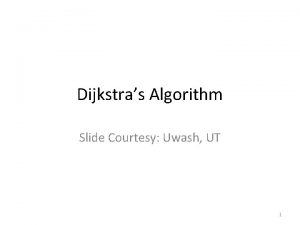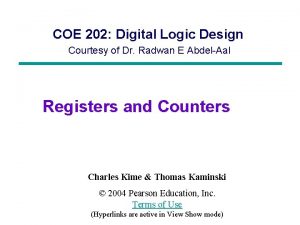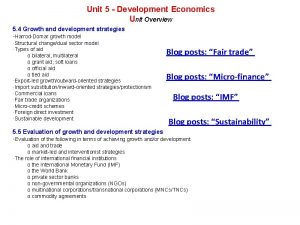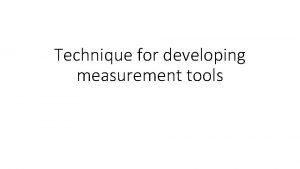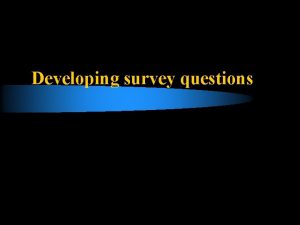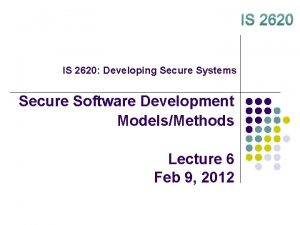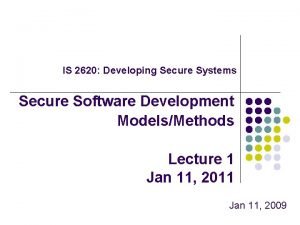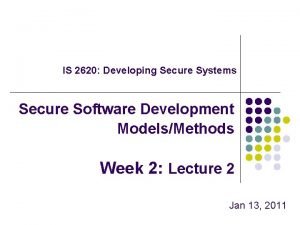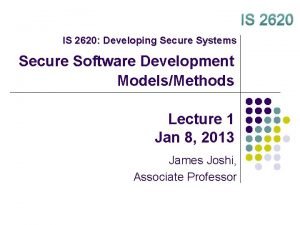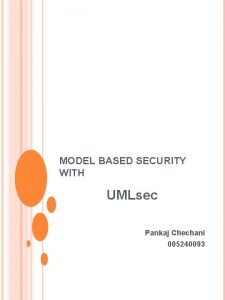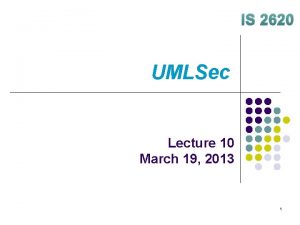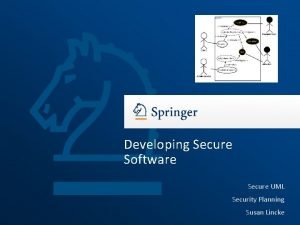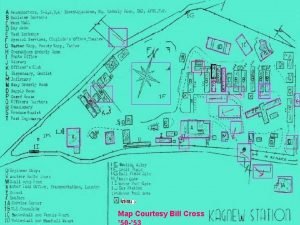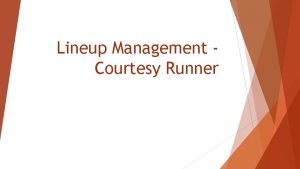UMLSec IS 2935 Developing Secure Systems Courtesy of


























































- Slides: 58

UMLSec IS 2935: Developing Secure Systems Courtesy of Jan Jürjens, who developed UMLsec Feb 6, 2006

Critical/High assurance Systems Development • High quality development of critical systems (dependable, security-critical, real-time, . . . ) is difficult. • Many systems developed, deployed, used that do not satisfy their criticality/security requirements, sometimes with spectacular failures. • Many flaws found in design/implementation – CERT reports No coherent and complete methodology to ensure security in the construction of large general-purpose systems exists … Courtesy of Jan Jürjens

Quality vs. cost • Systems on which human life and commercial assets depend need careful development. • Systems operating under possible system failure or attack need to be free from weaknesses/flaws • Correctness in conflict with cost. • Thorough methods of system design not used if too expensive. Courtesy of Jan Jürjens

Model-based Security • Goal: – Make the transition from human ideas to executed systems easy – Increase quality/assurance with bounded time-tomarket and cost. Requirements Models Code Courtesy of Jan Jürjens

Goal: Secure by Design Consider critical properties • from very early stages • within development context • taking an expansive view • seamlessly throughout the development lifecycle. High Assurance/Secure design by model analysis. High Assurance/Secure implementation by test generation. Courtesy of Jan Jürjens

Model-based Security Engineering Combined strategy: • Verify models against requirements • Generate code from models where reasonable • Write code and generate test sequences otherwise. Requirements Verify Models Code Gen. Test Gen. Code Courtesy of Jan Jürjens

Secure by design • Establish the system fulfills the security requirements – At the design level – By analyzing the model • Make sure the code is secure – Generate test sequences from the model Courtesy of Jan Jürjens

Using UML • UML – Provides unprecedented opportunity for highquality and cost- and time-efficient highassurance systems development: • De-facto standard in industrial modeling: large number of developers trained in UML. • Relatively precisely defined • Many tools (specifications, simulation, …). Courtesy of Jan Jürjens

Challenges • Adapt UML to critical system application domains. • Correct use of UML in the application domains. • Conflict between flexibility and unambiguity in the meaning of a notation. • Improving tool-support for critical systems development with UML (analysis, …). Courtesy of Jan Jürjens

UML Extension Goals • Extensions for high assurance systems development. – evaluate UML specifications for weaknesses in design – encapsulate established rules of prudent critical/secure systems engineering as checklist – make available to developers not specialized in critical systems – consider critical requirements from early design phases, in system context – make certification cost-effective Courtesy of Jan Jürjens

The High-assurance design UML profiles • Recurring critical security requirements, failure/adversary scenarios, concepts offered as stereotypes with tags on component-level. • Use associated constraints to evaluate specifications and indicate possible weaknesses. – Ensures that UML specification provides desired level of critical requirements. • Link to code via test-sequence generation. Courtesy of Jan Jürjens

UML - Review Unified Modeling Language (UML): • visual modeling for OO systems • different views on a system • high degree of abstraction possible • de-facto industry standard (OMG) • standard extension mechanisms Courtesy of Jan Jürjens

Summary of UML Components • Use case diagram – discuss requirements of the system • Class diagram – data structure of the system • Statechart diagram – dynamic component behavior • Activity diagram – flow of control between components Courtesy of Jan Jürjens • Sequence diagram – interaction by message exchange • Deployment diagram – physical environment • Package/Subsystem – collect diagrams for system part Current: UML 1. 5 (released Mar 2003)

Dependency dependency supertype subtype Courtesy of Jan Jürjens

UML run-through: Class diagrams • Class structure of system. • Classes with attributes and operations/signals; – relationships between classes. Courtesy of Jan Jürjens

UML run-through: Statecharts • Dynamic behavior of individual component. • Input events cause state change and output actions. e[g]/a Courtesy of Jan Jürjens event[guard]/action

UML run–through: Activity diagrams For each component or object A special case of State-chart action state Sub-activity Synchronization bar • Specify the control flow between components within the system, at higher degree of abstraction than state-charts and sequence diagrams. Courtesy of Jan Jürjens

UML run-through: Sequence Diagrams • Describe interaction between objects or components via message exchange. Courtesy of Jan Jürjens

UML Deployment diagrams Logical (connections) • Describe the physical layer on which the system is to be implemented. Courtesy of Jan Jürjens

UML Package • May be used to organize model elements into groups within a physical system Courtesy of Jan Jürjens

UML Extension mechanisms • Stereotype – specialize model element using «label» . – Adds security relevant information to model elements • Tagged value – attach {tag=value} pair to stereotyped element. • Constraint – refine semantics of stereotyped element. • Profile: – gather above information. Courtesy of Jan Jürjens

Basic Security Requirements Secrecy Information Integrity Information Availability Information Courtesy of Jan Jürjens

Basic Security Requirements II Authenticity Nonrepudiability Sender Information Sender Courtesy of Jan Jürjens

Problems • Many flaws found in designs of securitycritical systems, sometimes years after publication or use. • Spectacular Example (1997): – NSA hacker team breaks into U. S. Department of Defense computers and the U. S. electric power grid system. Simulates power outages and 911 emergency telephone overloads in Washington, D. C. . Courtesy of Jan Jürjens

Causes I • Designing secure systems correctly is difficult. • Even experts may fail: – Needham-Schroeder protocol (1978) – attacks found 1981 (Denning, Sacco), 1995 (Lowe) • Designers often lack background in security. • Security as an afterthought. Courtesy of Jan Jürjens

Causes II • “Blind” use of mechanisms: – Security often compromised by circumventing (rather than breaking) them. – Assumptions on system context, physical environment. “Those who think that their problem can be solved by simply applying cryptography don`t understand cryptography and don`t understand their problem” (Lampson, Needham). Courtesy of Jan Jürjens

Difficulties Exploit information spreads quickly. – Check the stats at CERT – Organizations hesitate to share • NCFTA addresses this • No feedback on delivered security from customers – Difficult to expect Courtesy of Jan Jürjens

Previous approaches • “Penetrate-and-patch”: unsatisfactory. – insecure • damage until discovered – disruptive • distributing patches costs money, destroys confidence, annoys customers) • Traditional formal methods: expensive. – training people – constructing formal specifications. Courtesy of Jan Jürjens

Holistic view on Security • Saltzer, Schroeder 1975: – “An expansive view of the problem is most appropriate to help ensure that no gaps appear in the strategy” – But “no complete method applicable to the construction of large general-purpose systems exists yet” (since 1975) Courtesy of Jan Jürjens

Requirements on UML extension Mandatory requirements: • Provide basic security requirements such as secrecy/confidentiality and integrity. • Allow considering different threat scenarios depending on adversary strengths. • Allow including important security concepts (e. g. tamper-resistant hardware). • Allow incorporating security mechanisms (e. g. access control). Courtesy of Jan Jürjens

Requirements on UML extension • Provide security primitives – e. g. (a)symmetric encryption • Allow considering underlying physical security. • Allow addressing security management – e. g. secure workflow • Optional requirements: – Include domain-specific security knowledge • Java, smart cards, CORBA, . . . Courtesy of Jan Jürjens

UMLsec: general ideas • Activity diagram – secure control flow, coordination • Class diagram – exchange of data preserves security levels • Sequence diagram – security-critical interaction Courtesy of Jan Jürjens • Statechart diagram – security preserved within object • Deployment diagram – physical security requirements • Package – holistic view on security

Stereotypes • Central idea – stereotypes • Add security relevant information to model elements of three kinds – Security assumptions on the physical level of the systems: e. g. , «Internet» – Security requirements on the logical structure of the system, e. g. , «secrecy» or specific data values, e. g. , «critical» Courtesy of Jan Jürjens

Stereotypes – Security policies that the system parts are supposed to obey; e. g. • «fair exchange» , «secure links» , «data security» , «no down-flow» • First two cases – Simply add some additional information to a model • Third one • Constraints are associated that needs to be satisfied by the model Courtesy of Jan Jürjens

UMLsec profile (excerpt) Stereotype Base class Internet link secure links subsystem secrecy dependency secure dependency subsystem no down-flow subsystem data security Tags guarded Subsystem access Courtesy of Jan Jürjens Description Internet connection dependency security matched by links enforces secure communication links assumes secrecy high subsystem fair exchange package Constraints start, stop call, send respect data security structural interaction data security prevents down-flow information flow provides secrecy, integrity basic data security requirements after start eventually reach stop enforce fair exchange guarded objects acc. through guards. access control using guard objects

<<Internet>> , <<encrypted>> , … • Kinds of communication links (resp. system nodes) • For adversary type A, stereotype s, have – Threats. A (s) ⊆ {delete, read, insert, access} of actions that adversaries are capable of. Default attacker: Stereotype • Internet Threatsdefault() {delete, read, insert} • encrypted {delete} • LAN • smart card Courtesy of Jan Jürjens

Requirements with use case diagrams Sales application <<fair exchange>> buys goods sells goods Customer Business • Capture security requirements in use case diagrams. • Constraint: – need to appear in corresponding activity diagram. Courtesy of Jan Jürjens

«fair exchange» • Ensures generic fair exchange condition – Avoid cheating • Constraint: – after a {start} state in activity diagram is reached, eventually reach {stop} state. – Cannot be ensured for systems that an attacker can stop completely. Courtesy of Jan Jürjens

«fair exchange» • Customer buys a good from a business. • Fair exchange means: – after payment, customer is eventually either delivered good or able to reclaim payment. “Pay” may be «provable» Courtesy of Jan Jürjens

<<secure links>> Example • Ensures that physical layer meets security requirements on communication. • Constraint: – for each dependency d with stereotype s in { <<secrecy>> , <<integrity>>} between components on nodes n, m, have a communication link l between n and m with stereotype t such that • if s = <<secrecy>> : have read ∉ Threats. A (t). • if s = <<integrity>> : have insert ∉ Threats. A (t). Courtesy of Jan Jürjens

<<secure links>> Example • Given default adversary type, is <<secure links>> provided ? Courtesy of Jan Jürjens

<<secure links>> Example • Given default adversary type, constraint for stereotype <<secure links>> violated: – According to the Threatsdefault(Internet) scenario • (read is in Threatsdefault(Internet)), – <<Internet>> link does not provide secrecy against default adversary. Courtesy of Jan Jürjens

<<secure dependency>> • Ensure that <<call>> and <<send>> dependencies between components respect security requirements on communicated data given by tags {secrecy}, {integrity} and {high}. • Constraint: – for <<call>> or <<send>> dependency from C to D (and similarly for {secrecy}): • Msg in D is {secrecy} in C if and only if also in D. • If msg in D is {secrecy} in C, dependency is stereotyped <<secrecy>>. Courtesy of Jan Jürjens

Example <<secure dependency>> provided ? Courtesy of Jan Jürjens

Example <<secure dependency>> Violates <<secure dependency>> : Random generator and <<call>> dependency do not give security level for random() to key generator. Courtesy of Jan Jürjens

<<no down–flow>> • Enforce secure information flow. • Constraint: – Value of any data specified in {secrecy} may influence only the values of data also specified in {secrecy}. Formalize by referring to formal behavioral semantics. Courtesy of Jan Jürjens

Example <<no down-flow>> <<no down–flow>> provided ? Courtesy of Jan Jürjens

Example <<no down-flow>> • <<no down–flow>> violated: partial information on input of high wm() returned by non-high rx(). Courtesy of Jan Jürjens

<<data security>> • Security requirements of data marked <<critical>> enforced against threat scenario from deployment diagram. • Constraints: Secrecy of {secrecy} data preserved. Integrity of {integrity} data preserved. Courtesy of Jan Jürjens

Example <<data security>> Variant of TLS (INFOCOM`99): <<data security>> against default adversary provided ? Courtesy of Jan Jürjens

Example <<data security>> Variant of TLS (INFOCOM`99): Violates {secrecy} of s against default adversary. Courtesy of Jan Jürjens

<<guarded access>> • Ensures that in Java, <<guarded>> classes only accessed through {guard} classes. • Constraints: – References of <<guarded>> objects remain secret. – Each <<guarded>> class has {guard} class. Courtesy of Jan Jürjens

Example <<guarded access>> • Provides <<guarded access>> : Access to Mic. Si protected by Mic. Gd. Courtesy of Jan Jürjens

Does UMLsec meet requirements? • • Security requirements: <<secrecy>> , … Threat scenarios: Use Threatsadv(ster). Security concepts: e. g. <<smart card>>. Security mechanisms: e. g. <<guarded access>>. Security primitives: Encryption built in. Physical security: Given in deployment diagrams. Security management: Use activity diagrams. Technology specific: Java, CORBA security. Courtesy of Jan Jürjens

Security Patterns • Security patterns: use UML to encapsulate knowledge of prudent security engineering. Example: Does not preserve security of account balance. Courtesy of Jan Jürjens

Solution: Wrapper Pattern • Technically, pattern application is transformation of specification. • Use wrapper pattern to ensure that no low read after high write. • Can check this is secure (once and for all). Courtesy of Jan Jürjens

Secure channel pattern: problem • To keep d secret, must be sent encrypted. Courtesy of Jan Jürjens

Secure channel pattern: (simple) solution Exchange certificate and send encrypted data over Internet. Courtesy of Jan Jürjens
 Umlsec
Umlsec Courtesy
Courtesy Umlsec
Umlsec Developing spreadsheet-based decision support systems
Developing spreadsheet-based decision support systems Acquiring information systems
Acquiring information systems Can we make operating systems reliable and secure
Can we make operating systems reliable and secure Courtesy notice
Courtesy notice Courtesy award
Courtesy award Completeness in communication
Completeness in communication Concreteness in technical writing
Concreteness in technical writing Courtesy traits
Courtesy traits 4 types of courtesy speeches
4 types of courtesy speeches Respect and discipline
Respect and discipline 7 c's effective communication
7 c's effective communication Crumbing down is a task carried out
Crumbing down is a task carried out Military courtesy definition
Military courtesy definition Greetings and farewells in english and spanish
Greetings and farewells in english and spanish Greetings farewells and courtesy expressions en español
Greetings farewells and courtesy expressions en español Legal profession complaints committee v in de braekt
Legal profession complaints committee v in de braekt Empirical formula to percent composition
Empirical formula to percent composition Courtesy formulas
Courtesy formulas Courtesy
Courtesy Courtesy
Courtesy Courtesy
Courtesy Slide courtesy
Slide courtesy Empirical formula with percentages
Empirical formula with percentages Abacbn
Abacbn Slide courtesy
Slide courtesy Counters courtesy
Counters courtesy Safteng
Safteng Courtesy
Courtesy Decision support systems and intelligent systems
Decision support systems and intelligent systems Dicapine
Dicapine Embedded systems vs cyber physical systems
Embedded systems vs cyber physical systems Engineering elegant systems: theory of systems engineering
Engineering elegant systems: theory of systems engineering Pretest: developing an academic and career plan
Pretest: developing an academic and career plan Harrod domar growth model
Harrod domar growth model Unit 4 school education system
Unit 4 school education system Nationalist position definition
Nationalist position definition Basic stages of multimedia project development
Basic stages of multimedia project development Rea diagram
Rea diagram Carly is given grapes and strawberries
Carly is given grapes and strawberries Adolescent egocentrism
Adolescent egocentrism Fast mapping
Fast mapping Development measurement tools
Development measurement tools Sample step
Sample step Polar front theory of a developing mid-latitude cyclone
Polar front theory of a developing mid-latitude cyclone Difference between developing and underdeveloped countries
Difference between developing and underdeveloped countries Chapter 35 developing a business plan
Chapter 35 developing a business plan Chapter 8 training and developing employees
Chapter 8 training and developing employees Transnational crime and the developing world
Transnational crime and the developing world Chapter 15 developing fraction concepts
Chapter 15 developing fraction concepts Download developing your leadership philosophy
Download developing your leadership philosophy Llikert scale
Llikert scale Character
Character Lesson 2 developing personal identity and character
Lesson 2 developing personal identity and character Null hypothesis vs alternative hypothesis
Null hypothesis vs alternative hypothesis What is the difference between direct and indirect guidance
What is the difference between direct and indirect guidance Guidance skills definition
Guidance skills definition
